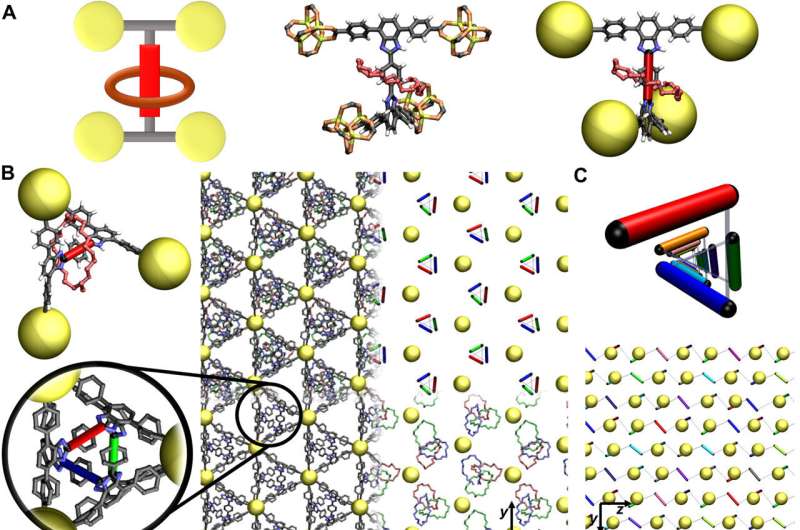Molecular structure of the rotaxane functionalized MOF.(A) Representation of one organic linker connecting four inorganic Zn4O corners. The left image sketches the structure of the building block, the center image shows an atomistic picture of the building block in ball-and-stick representation, and the right image shows a simplification of the atomistic picture. The inorganic corners are visualized by big yellow balls and the molecular crossbar (rotaxane axle) is simplified by a red stick. (B) Visualization of the pore structure from the z direction (top view). The image in the top left corner shows the orientation of the building block from the z direction. The picture at the right side shows the pore structure of the periodically assembled MOF structure. For clarity, different parts of the MOF are omitted, highlighting the arrangement of the crossbars (right top excerpt, simplified by a colored stick representation), the organic linkers (bottom left excerpt), and the rings (bottom right excerpt). The zoom-in view illustrates the relative arrangement of three linkers within a pore. (C) Illustration of the arrangement of the crossbars in the z direction. Top image shows a perspective view on the molecular helix, formed by the crossbars within a pore. Bottom image shows the chain-like arrangement along the z direction. The thin gray connection between the crossbars (colored sticks) is only a guide to the eye emphasizing the chain structure. (D) Differentiation of ring arrangements into three cases, each with different local environments. (E) Radial distribution function (RDF) measuring the relative distance between the rings for all three cases (M, violet graph; D, green graph; T, dark blue graph). The red line marks the distance to an adjacent one-dimensional chain. Credit: Science Advances (2022). DOI: 10.1126/sciadv.abn4426
Physicists at the University of Münster are the first to successfully reveal the dynamic interaction of a class of artificial molecular machines—the so-called molecular shuttles—by using molecular-dynamic simulations. The study has now been published in Science Advances.
Molecular machines control a sizeable number of fundamental processes in nature. Embedded in a cellular environment, these processes play a central role in the intracellular and intercellular transportation of molecules, as well as in muscle contraction in humans and animals. In order for the entire organism to function, a well-defined orientation and arrangement of the molecular machines is essential. For example, the specific embedding of motor proteins—which form a class of biomolecular machines—enable a dynamic interaction to take place among the countless proteins. As a result, movement at the molecular level is amplified and transferred through various magnitudes up to the macroscopic level.
Inspired by these biological systems, the development of cell-type materials based on artificial molecular machines is a current field of research. In order to use the molecular cooperativity of these machines in corresponding materials specifically for applications in materials science or medicine, a detailed understanding both of the molecular embedding in a matrix and of the intermolecular interactions is decisive. Elena Kolodzeiski and Dr. Saeed Amirjalayer from the Institute of Physics at the University of Münster are the first to successfully reveal the dynamic interaction of a class of artificial molecular machines—the so-called molecular shuttles—by using molecular-dynamic simulations.
Molecular shuttles are constructed from dumbbell-shaped and ring-shaped molecules which are linked to one another through mechanical bonds. "This mechanical link at the molecular level leads to the ring being able to move directed from one side to the other along the axis. This specific pendulum movement has already been used to develop molecular machines," explains Amirjalayer, who headed the study and recently moved to the Institute of Solid-State Theory at Münster University.
Based on this, researchers worldwide are working on a targeted use of these molecular machines in functional materials. Metal-organic frameworks, which are assembled in a modular approach by organic and inorganic building units, show themselves to be a promising matrix for embedding these mechanically interlinked molecules in cell-type structures. Although a series of these systems have been synthesized over the past years, a fundamental understanding of the dynamic processes in these materials has mostly been lacking.
"Our study provides a detailed insight into how embedded machines function and interact," says lead author Elena Kolodzeiski. "At the same time, we were able to derive parameters which make it possible to vary the type of movement of the molecular shuttles within the metal-organic frameworks."
A targeted control of the dynamics offers promising possibilities for influencing the transport properties of molecules in membranes or for coordinating catalytic processes. The researchers hope that their molecular dynamic simulations will form the basis for new types of materials for catalytic and medical applications. Just how efficient such materials can be is shown by the various functionalities of the molecular machines in biological cells.
More information: Elena Kolodzeiski et al, Dynamic network of intermolecular interactions in metal-organic frameworks functionalized by molecular machines, Science Advances (2022). DOI: 10.1126/sciadv.abn4426
Journal information: Science Advances
Provided by University of Münster
























